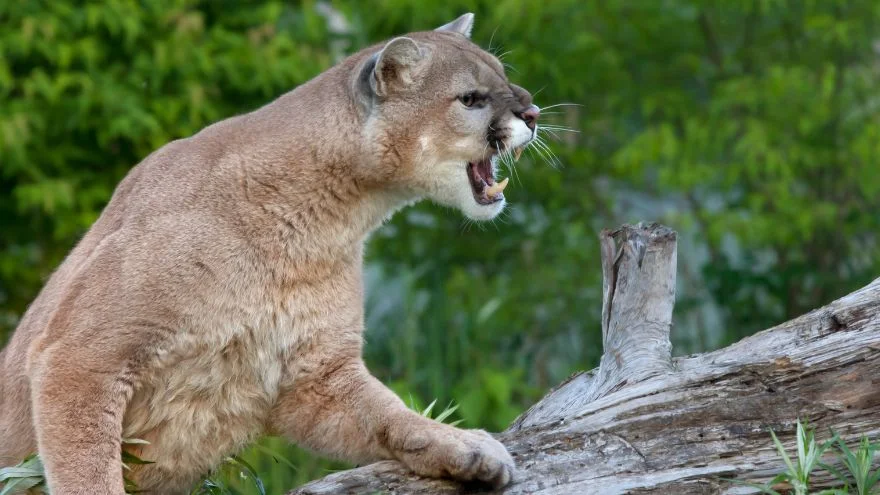Oklahoma is home to some of the deadliest animals in the United States, and you should avoid them as much as possible. The most dangerous animals in Oklahoma include venomous snakes, poisonous spiders, mountain lions, etc.
Oklahoma is a fairly big state located in the southern part of the United States of America.
It is known for the scenery of the great plains and the robust culture of the Muscogee and Cherokee tribes.
Other fascinating things are the vast majority of deadly but fascinating animals spread across the 20th largest state in the U.S.
Keep reading for a comprehensive highlight of the top 10 deadliest and most dangerous animals that live in Oklahoma and some wildlife safety tips you should know.
What are the Most Dangerous Animals in Oklahoma?
1. Mountain Lions
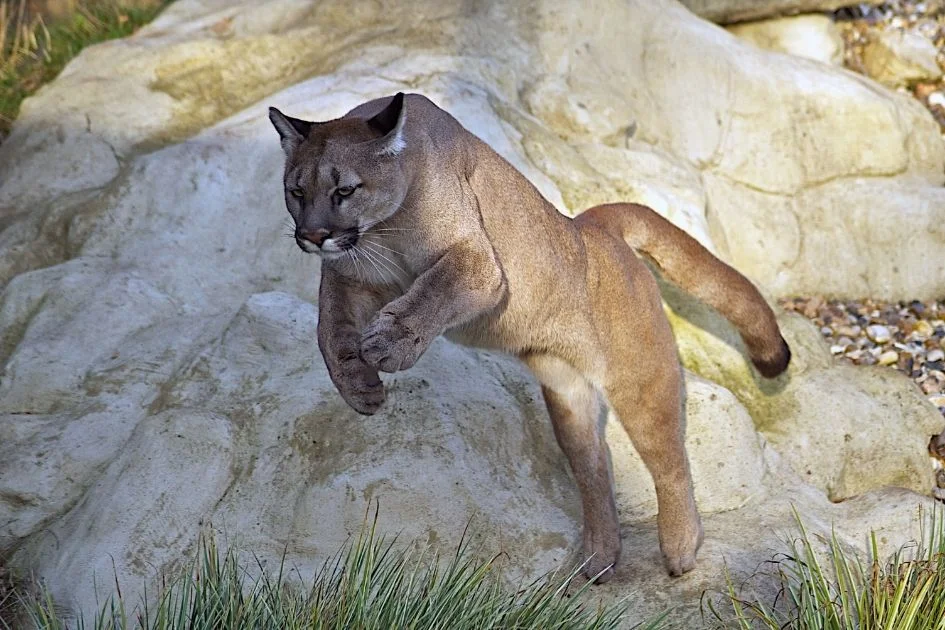
- Scientific name: Puma concolor
- Classifications: Mammals
- Habitat: Thick forests and mountain regions
- Diet: Carnivores
- Conservation status: Endangered
The mountain lion, also called puma or cougar, is the second largest cat in the world.
Mountain lions in the past roamed Oklahoma but are almost extinct today due to harmful human activities such as trapping and excessive hunting.
Even though these creatures’ population has reduced over time, some have been sighted recently in the thick forests of Oklahoma.
Mountain lions are mostly solitary creatures and only come out to hunt or drink.
Although mountain lion attacks are rare, it is advisable to be wary when venturing into its habitat as they can get very aggressive when they feel threatened.
2. Black Bears

- Scientific name: Ursus americanus
- Classifications: Mammals
- Habitat: Rough terrains with thick vegetation and mountain terrains.
- Diet: Carnivores
- Conservation status: Least concern
Black bears are a small species of bears, and they are present across America.
The black bear population has increased over time and is considered one of the most dangerous animals in Oklahoma, which prompted its hunting to be allowed.
Black bears are unpredictable, so it is advised to take special precautions when hiking or camping in the woods, stay in groups always and keep food and other edibles always covered as their scent could attract the bears.
Even though attacks on humans are rare, black bears are known to attack even when unprovoked.
Due to the recent increase in its population, the chances of coming across one of one venturing into a human community have become increasingly high.
3. Tigers

- Scientific name: Panthera tigris
- Classification: Mammal
- Habitat: Forests
- Diet: Carnivores
- Conservation status: Endangered
Tigers, also known as the Panthera tigris, are the largest species of the cat family alive. They mostly roam in isolation and are powerful predators feeding mainly on wild boars and deer.
The tiger cubs cohabit with their mothers for some time (2 years) before migrating to other territories to live.
Tigers are considered the most dangerous wild animal in Oklahoma, and cases of Tiger attacks are very rare and almost non-existent.
If you come in contact with animals like tigers in Oklahoma, it is best to avoid them. Do not attempt to attack them or get close to them.
4. Feral Hogs
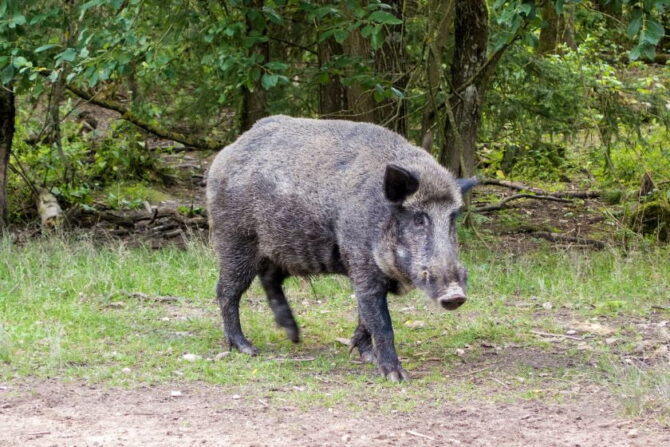
- Scientific name: Sus scrofa
- Classification: Mammals
- Habitat: swamps and brushlands
- Diet: Carnivores
- Conservation status: Least concern
Feral hogs or pigs are domestic pigs that have gone feral and ventured into the wild.
They are primarily nocturnal animals and are considered one of the most aggressive and deadliest animals in Oklahoma.
They pose a danger to humans through direct attack, tend to destroy crops and vegetation in their search for food, and carry diseases that the pigs transmit to humans and other animals.
Feral hogs are highly territorial, making them extremely aggressive. When one comes in contact with a feral hog, it is advisable to find a high ground as quickly as possible.
5. Prairie Rattlesnake
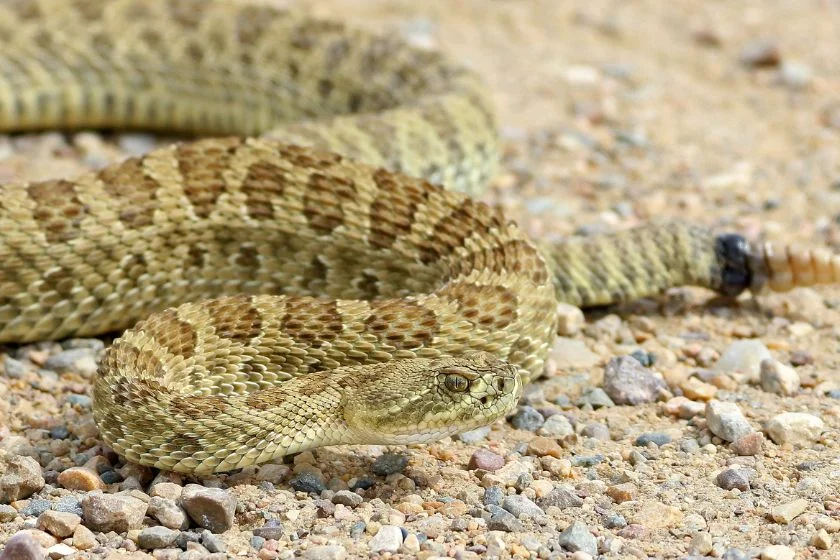
- Scientific name: Crotalus viridis
- Classification: Reptiles
- Habitat: grasslands and plains
- Diet: Carnivores
- Conservation status: Least concern
Common in terrains, like large open grasslands, these pit vipers are pretty easy to find in Oklahoma; the terrains serve as a perfect habitat for their survival.
Prairie rattlesnakes are highly venomous snakes that can grow to lengths of about two meters, with a brown or black tint color on their upper side.
These snakes are great at camouflage and can blend their color with the vegetation around them.
Prairie rattlesnakes are territorial, which makes them very dangerous. They release potent neurotoxins into their victims, which can lead to death.
Hence, it is crucial to be vigilant when venturing into grasslands as one could be hidden under the brushes since they are perfect in camouflage.
6. Pygmy Rattlesnake
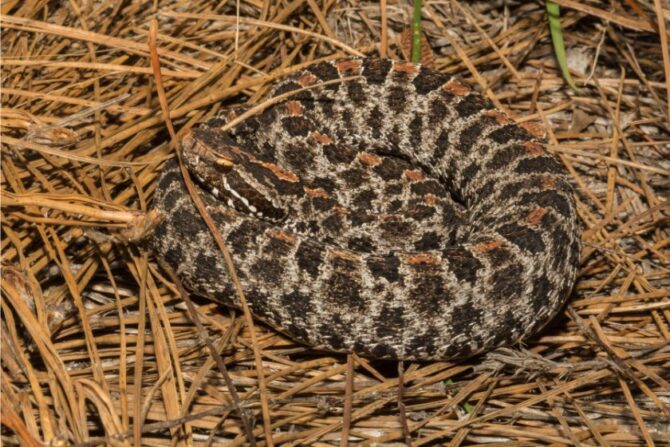
- Scientific name: Sistrurus miliarius
- Classification: Reptiles
- Habitat: Low forests, floodplains, and marshes
- Diet: Carnivores
- Conservation status: Least concern
Another deadly reptile worth mentioning is the Pygmy rattlesnake. This reptile is highly venomous and produces hemorrhagic toxins that can cause quick death, which is why they are sometimes called death rattlers.
They are small, with a maximum length of about one meter, and due to the type of terrain and vegetation found in Oklahoma, these snakes are very common.
These reptiles can be unnoticeable due to their small nature but can be spotted from the rattling sound it makes.
Some can be vicious and strike without provocation, so it is advisable always to be vigilant when venturing into its terrain.
7. Diamondback Rattlesnake

- Scientific name: Crotalus atrox
- Classification: Reptiles
- Habitat: flat plains and rocky hillsides
- Diet: Carnivores
- Conservation status: Least concern
The diamondback rattlesnake is a highly venomous snake and is known to be responsible for the majority of snakebite deaths in the U.S, including Oklahoma.
It is also the largest rattlesnake you can find in Oklahoma. Its name ‘diamondback’ comes from the diamond-shaped patterns on their backs.
They are known to grow to about six feet long and could as much as seven kilograms with greyish-brown, pinkish, or whitish color patterns.
These vipers are common in the state and are known to be vicious and aggressive, especially during mating season.
8. Western Cottonmouth

- Scientific name: Agkistrodon piscivorus
- Classification: Reptiles
- Habitat: water bodies like streams, lakes, and marshes
- Diet: Carnivores
- Conservation status: Least concern
The cottonmouth viper is one of the most unpleasant slithering creatures one can come across.
It is advisable to run in the opposite direction once it is spotted because these snakes often prefer confrontation, and being highly venomous at attack could be lethal.
You should also note that the cottonmouth is one of the world’s few semiaquatic snakes and can survive in water as efficiently as it survives on land, making it even more dangerous.
Adults could grow to 90cm or more lengths and weigh up to five kilograms.
Their color pattern consists of brown with an overlay of black and yellowish bands.
9. Black Widow Spider

- Scientific name: Latrodectus tredecimguttatus
- Classification: Arachnids
- Habitat: Dark, clustered places like cupboards, closets, or crevices.
- Diet: Carnivores
- Conservation status: Least conservative
Black widow spiders are a common sight in Oklahoma, and they are considered dangerous due to their conspicuity and the fatality of their bites.
These spiders are mostly found in the dark, abandoned buildings, garages, and on small trees.
Hence one should take special care when rummaging through such places.
The toxin from a black widow is highly lethal, and symptoms from its bite include profuse sweating and goose bumps, uncontrollable muscle spasms, and eventual tissue breakdown, which can eventually lead to death.
10. American Bison
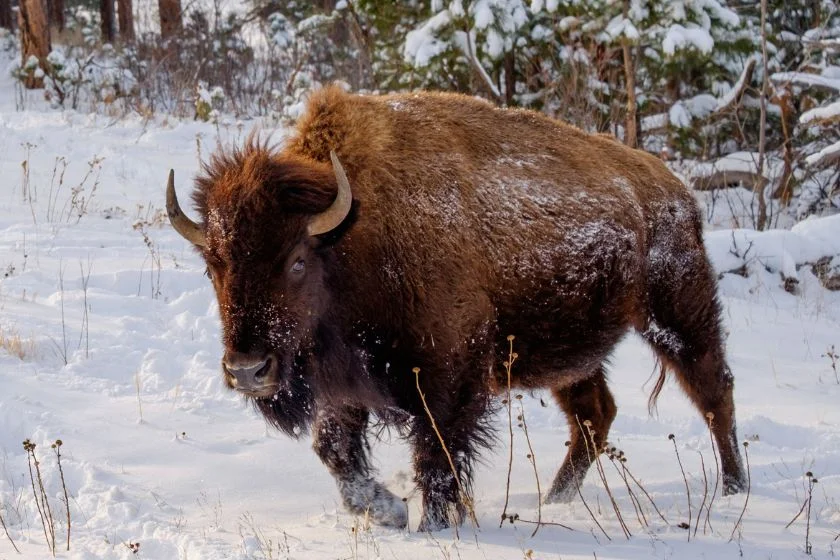
- Scientific name: Bos bison
- Classification: Mammals
- Habitat: River valleys, plains, and prairies.
- Diet: Herbivores
- Conservation status: Endangered
American Bison, also called Bos bison, is another wild animal found in Oklahoma.
Though they may not be as dangerous as Tigers or mountain lions, they are highly unpredictable and may attack unexpectedly.
If you come across American Bison in Oklahoma, do not get too close to them as they may attack suddenly. They should be avoided and observed at a safe distance.
Related:
Are There Wolves In Oklahoma?
Oklahoma Wildlife Safety Tips
When venturing into the wild of Oklahoma, it is important to adhere strictly to some safety wildlife tips to ensure a hazard-free outing.
Some of these tips are as follows;
- Wear bright clothing so other people can spot you easily in case of danger: In case of danger, wearing dull-colored clothing such as grey or ash makes it difficult for identification, and it might be a little too late before being spotted.
- Always check tree stands for snakes: Tree stands are some places where snakes live; it is essential to thoroughly check the trees around you before deciding to rest or climb.
- Always use a harness and a tree rope to climb onto a tree: Safety climbing tools like tree ropes and harnesses are vital for safety when climbing trees. Ensure to use them consistently and appropriately at all times.
- Wear gloves and try to avoid cuts as much as possible: This prevents the risk of diseases. Protective tools like gloves will help protect the skin against bites and not expose the skin to diseases.
- Always wear appropriate supplies if you get stranded in the wild: To avoid being stranded or in need while exploring wildlife. Ensure you pack all the supplies you will need for your exploration.
- Be mentally aware of your surroundings: When exploring the wildlife, it is essential to check your surroundings properly. Before stepping on the ground, check to ensure you are not stepping on anything dangerous.
Final Thoughts
Among several most dangerous animals in Oklahoma, snakes are the most common and deadliest; these vipers are widespread all over the state.
Hence it is very important to be cautious of the surroundings as one might not be aware of the dangers lurking.
Attack from these creatures could be fatal and deadly, which makes it important to have a little knowledge about them and how to take the necessary safety precautions when venturing into unknown territory.
